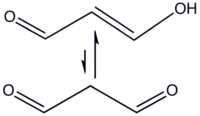Malondialdehyde
 | |||
| |||
| Names | |||
|---|---|---|---|
| IUPAC name
propanedial | |||
| Other names
Malonic aldehyde; Malonodialdehyde; Propanedial; 1,3-Propanedial ; Malonaldehyde | |||
| Identifiers | |||
| 542-78-9 | |||
| 3D model (Jmol) | Interactive image | ||
| Abbreviations | MDA | ||
| ChemSpider | 10499 | ||
| KEGG | C19440 | ||
| PubChem | 10964 | ||
| |||
| |||
| Properties | |||
| C3H4O2 | |||
| Molar mass | 72.06 g·mol−1 | ||
| Appearance | Needle-like solid[1] | ||
| Density | 0.991 g/mL | ||
| Melting point | 72 °C (162 °F; 345 K) | ||
| Boiling point | 108 °C (226 °F; 381 K) | ||
| Hazards | |||
| US health exposure limits (NIOSH): | |||
| PEL (Permissible) |
none[1] | ||
| REL (Recommended) |
Ca[1] | ||
| IDLH (Immediate danger) |
Ca [N.D.][1] | ||
| Related compounds | |||
| Related alkenals |
Glucic acid | ||
| Except where otherwise noted, data are given for materials in their standard state (at 25 °C [77 °F], 100 kPa). | |||
| | |||
| Infobox references | |||
Malondialdehyde (MDA) is the organic compound with the formula CH2(CHO)2. The structure of this species is more complex than this formula suggests. This reactive species occurs naturally and is a marker for oxidative stress.
Structure and synthesis
Malondialdehyde mainly exists in the enol form:[2]
- CH2(CHO)2 → HOCH=CH-CHO
In organic solvents, the cis-isomer is favored, whereas in water the trans-isomer predominates.
Malondialdehyde is a highly reactive compound that is not typically observed in pure form. In the laboratory it can be generated in situ by hydrolysis of 1,1,3,3-tetramethoxypropane, which is commercially available.[2] It is easily deprotonated to give the sodium salt of the enolate (m.p. 245 °C).
Malondialdehyde results from lipid peroxidation of polyunsaturated fatty acids.[3] It is a prominent product in Thromboxane A2 synthesis wherein cyclooxygenase 1 or cycloxygenase 2 metabolizes arachidonic acid to prostaglandin H2 by platelets and a wide array of other cell types and tissues. This product is further metabolized by Thromboxane synthase to Thromboxane A2, 12-Hydroxyheptadecatrienoic acid, and malonyldialdehyde.[4][5] Alternatively, it may rearrange non-enzymatically to a mixture of 8-cis and 8-trans isomers of 12-hydroxyeicosaheptaenoic acid plus malonyldialdehyde (see 12-Hydroxyheptadecatrienoic acid).[6] The degree of lipid peroxidation can be estimated by the amount of malondialdehyde in tissues.[3]
Biochemistry
Reactive oxygen species degrade polyunsaturated lipids, forming malondialdehyde.[7] This compound is a reactive aldehyde and is one of the many reactive electrophile species that cause toxic stress in cells and form covalent protein adducts referred to as advanced lipoxidation end-products (ALE), in analogy to advanced glycation end-products (AGE).[8] The production of this aldehyde is used as a biomarker to measure the level of oxidative stress in an organism.[9][10]
Malondialdehyde reacts with deoxyadenosine and deoxyguanosine in DNA, forming DNA adducts, the primary one being M1G, which is mutagenic.[11] The guanidine group of arginine residues condense with malondialdehyde to give 2-aminopyrimidines.
Human ALDH1A1 aldehyde dehydrogenase is capable of oxidizing malondialdehyde.
Analysis
Malondialdehyde and other thiobarbituric reactive substances (TBARS) condense with two equivalents of thiobarbituric acid to give a fluorescent red derivative that can be assayed spectrophotometrically.[2][12] 1-Methyl-2-phenylindole is an alternative more selective reagent.[2]
Hazards and pathology
Malondialdehyde is reactive and potentially mutagenic.[13] It has been found in heated edible oils such as sunflower and palm oils.[14]
Corneas of patients suffering from keratoconus and bullous keratopathy have increased levels of malondialdehyde, according to one study.[15] MDA also can be found in tissue sections of joints from patients with osteoarthritis.[16]
See also
References
- 1 2 3 4 "NIOSH Pocket Guide to Chemical Hazards #0377". National Institute for Occupational Safety and Health (NIOSH).
- 1 2 3 4 V. Nair, C. L. O'Neil, P. G. Wang "Malondialdehyde", Encyclopedia of Reagents for Organic Synthesis, 2008, John Wiley & Sons, New York. doi:10.1002/047084289X.rm013.pub2 Article Online Posting Date: March 14, 2008
- 1 2 Davey MW1, Stals E, Panis B, Keulemans J, Swennen RL (2005). "High-throughput determination of malondialdehyde in plant tissues". Analytical Biochemistry. 347 (2): 201–207. doi:10.1016/j.ab.2005.09.041. PMID 16289006.
- ↑ J. Biol. Chem. 248:5673; 1973
- ↑ Proc. Natl. Acad. Sci. USA 71:3400; 1974
- ↑ Prostaglandins Other Lipid Mediat. 1998 Jun;56(2-3):53-76
- ↑ Pryor WA, Stanley JP (1975). "Letter: A suggested mechanism for the production of malondialdehyde during the autoxidation of polyunsaturated fatty acids. Nonenzymatic production of prostaglandin endoperoxides during autoxidation". J. Org. Chem. 40 (24): 3615–7. doi:10.1021/jo00912a038. PMID 1185332.
- ↑ Farmer EE, Davoine C (2007). "Reactive electrophile species". Curr. Opin. Plant Biol. 10 (4): 380–6. doi:10.1016/j.pbi.2007.04.019. PMID 17646124.
- ↑ Moore K, Roberts LJ (1998). "Measurement of lipid peroxidation". Free Radic. Res. 28 (6): 659–71. doi:10.3109/10715769809065821. PMID 9736317.
- ↑ Del Rio D, Stewart AJ, Pellegrini N (2005). "A review of recent studies on malondialdehyde as toxic molecule and biological marker of oxidative stress". Nutr Metab Cardiovasc Dis. 15 (4): 316–28. doi:10.1016/j.numecd.2005.05.003. PMID 16054557.
- ↑ Marnett LJ (1999). "Lipid peroxidation-DNA damage by malondialdehyde". Mutat. Res. 424 (1–2): 83–95. doi:10.1016/S0027-5107(99)00010-X. PMID 10064852.
- ↑ http://www.amdcc.org/shared/showFile.aspx?doctypeid=3&docid=33 Archived September 14, 2006, at the Wayback Machine.
- ↑ Hartman PE, Putative mutagens and carcinogens in foods. IV. Malonaldehyde (malondialdehyde) Environ Mutagen. 1983;5(4):603-7
- ↑ Dourerdjou, P.; Koner, B. C. (2008), Effect of Different Cooking Vessels on Heat-Induced Lipid Peroxidation of Different Edible Oils" Journal of Food Biochemistry, 32: 740–751. doi:10.1111/j.1745-4514.2008.00195.x
- ↑ Buddi R, Lin B, Atilano SR, Zorapapel NC, Kenney MC, Brown DJ (March 2002). "Evidence of oxidative stress in human corneal diseases". J. Histochem. Cytochem. 50 (3): 341–51. doi:10.1177/002215540205000306. PMID 11850437.
- ↑ Tiku ML, Narla H, Jain M, Yalamanchili P (2007). "Glucosamine prevents in vitro collagen degradation in chondrocytes by inhibiting advanced lipoxidation reactions and protein oxidation". Arthritis Research & Therapy. 9 (4): R76. doi:10.1186/ar2274. PMC 2206377
 . PMID 17686167.
. PMID 17686167.

